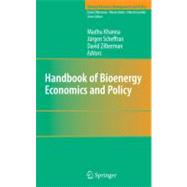
What is included with this book?
| Introduction | |
| Bioenergy Economics and Policy: Introduction and Overview | p. 3 |
| Are Biofuels the Best Use of Sunlight? | p. 15 |
| Perennial Grasses as Second-Generation Sustainable Feedstocks Without Conflict with Food Production | p. 27 |
| Present and Future Possibilities for the Deconstruction and Utilization of Lignocellulosic Biomass | p. 39 |
| Interactions Between Biofuels, Agricultural Markets and Trade | |
| Price Transmission in the US Ethanol Market | p. 55 |
| Biofuels and Agricultural Growth: Challenges for Developing Agricultural Economies and Opportunities for Investment | p. 73 |
| Prospects for Ethanol and Biodiesel, 2008 to 2017 and Impacts on Agriculture and Food | p. 91 |
| The Global Bioenergy Expansion: How Large Are the Food-Fuel Trade-Offs? | p. 113 |
| Demand Behavior and Commodity Price Volatility Under Evolving Biofuel Markets and Policies | p. 133 |
| Designing the Infrastructure for Biofuels | |
| Optimizing the Biofuels Infrastructure: Transportation Networks and Biorefinery Locations in Illinois | p. 151 |
| The Capital Efficiency Challenge of Bioenergy Models: The Case of Flex Mills in Brazil | p. 175 |
| Environmental Effects of Biofuels and Biofuel Policies | |
| Could Bioenergy Be Used to Harvest the Greenhouse: An Economic Investigation of Bioenergy and Climate Change? | p. 195 |
| A Simple Framework for Regulation of Biofuels | p. 219 |
| Market and Social Welfare Effects of the Renewable Fuels Standard | p. 233 |
| US-Brazil Trade in Biofuels: Determinants, Constraints, and Implications for Trade Policy | p. 251 |
| Food and Biofuel in a global Environment | p. 267 |
| Meeting Biofuels Targets: Implications for Land Use, Greenhouse Gas Emissions, and Nitrogen Use in Illionois | p. 287 |
| Corn Stover Harvesting: Potential Supply and Water Quality Implications | p. 307 |
| Economic Effects of Bioenergy Policies | |
| International Trade Patterns and Policy for Ethanol in the United States | p. 327 |
| The Welfare Economics of Biofuel Tax Credits and Mandates | p. 347 |
| Biofuels, Policy Options, and Their Implications: Analyses Using Partial and General Equilibrium Approaches | p. 365 |
| Welfare and Equity Implications of Commercial Biofuel | p. 385 |
| European Biofuel Policy: How Far Will Public Support Go? | p. 401 |
| Conclusions | p. 425 |
| Index | p. 431 |
| Table of Contents provided by Ingram. All Rights Reserved. |
The New copy of this book will include any supplemental materials advertised. Please check the title of the book to determine if it should include any access cards, study guides, lab manuals, CDs, etc.
The Used, Rental and eBook copies of this book are not guaranteed to include any supplemental materials. Typically, only the book itself is included. This is true even if the title states it includes any access cards, study guides, lab manuals, CDs, etc.